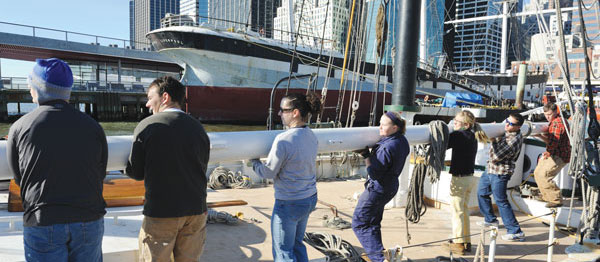 Several years ago I took a sail on the AJ Meerwald in New York harbor. While on the sail I saw the schooner Pioneer, owned and operated by the South Street Seaport Museum, also sailing in the harbor. Despite having lived in and around New York harbor for decades, I knew nothing about the Pioneer. I asked the mate on the Meerwald what she knew of the schooner. She said something to the effect that they had a fantastic group of volunteers but that the museum management did a lousy job of promoting the schooner.
Several years ago I took a sail on the AJ Meerwald in New York harbor. While on the sail I saw the schooner Pioneer, owned and operated by the South Street Seaport Museum, also sailing in the harbor. Despite having lived in and around New York harbor for decades, I knew nothing about the Pioneer. I asked the mate on the Meerwald what she knew of the schooner. She said something to the effect that they had a fantastic group of volunteers but that the museum management did a lousy job of promoting the schooner.
Unfortunately that never changed. The South Street Seaport Museum continued to have a loyal and hardworking group of volunteers, while the museum management continued to do a lousy job. This continued until last February when the museum collapsed financially, staff was laid off and the volunteers were turned away.
An interesting thing happened. A group of volunteers formed Save Our Seaport and turned their energies toward saving the museum – holding public meetings circulating petitions and doing all they could to save an institution so badly served by past managers. The good news is that the museum has been taken over by the Museum of New York and last weekend, the volunteers were allowed back in. Forty five people assembled on Pier 16 and got to work moving spars and cleaning up debris.. There could be no clearer sign that the South Street Seaport Museum is on its way back.
Seaport Museum volunteers go back to work
After a hiatus of more than seven months, it was the first day back for a group of volunteers who not only had dedicated themselves to helping maintain the South Street Seaport Museum’s historic ships in the past, but who had fought to keep their condition in the public eye during the long period when the museum’s future was in doubt.
“I’m extremely excited to be back,” said Mike Cohen, one of the volunteers. “We feel it’s indicative of a turnaround.”
Jonathan Boulware, waterfront director for the South Street Seaport Museum, who has been with the museum for around a month, said, “Today the biggest project is to clean up the waterfront. It’s a chance to get trash out and sweep and mop – all the things you do in a fall or spring cleaning in your house.”
One of the volunteers pointed out a dumpster that they hoped to fill by the end of the day with trash from the 11 floating objects — ships and barges — owned by the museum.
